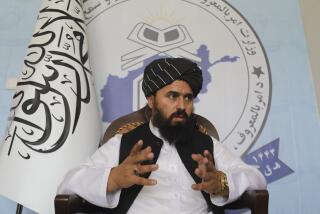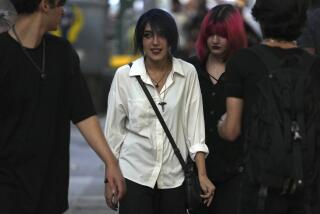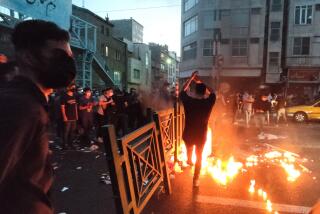For Pakistani women, dupattas are more than a fashion statement
Reporting from Karachi, Pakistan — Seeking a competitive edge, fabric designer Vaneeza Ahmad spent hours on the phone to China but couldn’t find anyone to make her new line of dupattas, the omnipresent scarves that Pakistani women drape over their arms, head, chest.
China may be the world’s factory floor, but its scarf makers aren’t equipped for something that can be more than 8 feet long. Ahmad fretted, until, after much wrangling, she found a solution.
“I’ve located a curtain maker who could do it,” she said triumphantly. “They’ve got the only machines big enough to handle our dupattas.”
Essence of femininity, grist for film and literature, political statement, cultural icon, albatross, these few ounces of cotton or silk fabric have woven their way across Pakistan’s shoulders, history and fashion runways, morphing from protest symbol to political must-have to sometimes-burdensome accessory demanded by Islamic fundamentalists.
The South Asian dupatta, which lies somewhere between its religious cousins -- the shorter head scarf popular in Turkey and Indonesia and the take-no-prisoners niqab and abaya worn in Saudi Arabia -- is such a fixture of Pakistani culture that many women here say they feel naked without one.
And while it may grow longer or shorter, wider or narrower, plainer or more extravagant with fashion’s whims, it’s a long-standing fixture in this conservative Islamic country, with a role in bolstering izzat, or modesty and respect. Nearly all Pakistani women wear a dupatta, at least occasionally.
“It has a multitude of uses,” said designer Rizwan Beyg, who outfitted the late Princess Diana -- she declined to wear a dupatta with his ensemble -- on one of her visits to Pakistan. “While its main use is to cover the boobs, butt and head, it can also be a sash, even a belt.”
The dupatta played a cameo role in the 1947 founding of Pakistan, but its first appearance, some claim, dates back 4,000 years to the Indus Valley civilization, evidenced by sculpture from the period showing high priests apparently wearing dupattas.
As Britain’s grip weakened in the 1940s, young Muslim women campaigning for the creation of Pakistan used their dupattas to make a statement. Caught without a green-and-white Muslim League flag, writer Mumtaz Shahnawaz famously whipped off her green dupatta on the roof of the Lahore jail to vent her discontent. Weeks later, 14-year-old Fatima Sughra used hers to replace the Union Jack atop a Punjab government building.
More than anything, the scarf’s bit role in history may reflect its being in the right place at the right time.
“The dupatta was a stand-in,” said Mohsin Sayeed, a Karachi-based fashion writer. “They weren’t going to take off their bras and wave those around.”
The early 1960s, a relatively wild period by Pakistani standards, saw the dupatta become shorter and less important. But religious conservatism and nationalism reasserted themselves toward the end of the decade. In 1966, Pakistan International Airways’ new uniforms for flight attendants, designed by Pierre Cardin, replaced pert pillbox hats with what www.historyofpia.com describes as an “imaginatively molded dupatta that not only covered heads but also turned heads.”
The dupatta and its traditional partner, the two-piece tunic and pants ensemble called a shalwar kameez, saw a renaissance under dictator Zia ul-Haq in the mid-1970s. He discouraged Western clothing, all but banned the sari as “too Indian” and launched a campaign to “look Pakistani.”
Women on state-run television were ordered to cover their heads as part of Zia’s religious-nationalist vision. News readers who refused were fired, leading others in defiance to pin the fabric’s edge to their hair, a look some likened to the landing of a tiny UFO.
The Pakistani perhaps most associated with the dupatta was the first woman to head a Muslim state, former Prime Minister Benazir Bhutto, who was killed in 2007.
Educated overseas, Bhutto embraced the dupatta as a way to downplay her Western lifestyle and boost her voter appeal as a pious Muslim woman.
“It’s sort of like a nun in the West, that men shouldn’t think of her as sexy,” said Kamiar Rokni, a fashion designer.
Maheen Khan, who designed Bhutto’s inauguration outfit, said her original dupatta kept slipping off, so she suggested using white chiffon, which hung better and looked patriotic when matched with a green shalwar kameez -- the colors of Pakistan’s flag.
Bhutto loved the idea and made it a fixture.
More recently, some women have complained of harassment and lewd comments in bazaars and other public places if they don’t wear a dupatta, or don’t drape it on their head, as Taliban-inspired fear spreads and society grows increasingly conservative.
“Without one, you’re seen as wanton,” said Shaheen Khan, 59, a homemaker in Karachi.
Lahore Arts Council curator Tanya Sohail, who sometimes leaves home without hers, said her response to men who make rude comments is that the Koran also tells men to not look inappropriately at women and to keep their eyes downcast.
“They’re taken aback,” she said. “They don’t expect a woman to talk back and question their morals.”
But the key to the dupatta’s staying power is its versatility, its champions say.
In the course of a day, an urban Pakistani woman may switch roles from entrepreneur to ingenue to pious daughter, in keeping with this country’s nuanced and often-contradictory sense of self. The dupatta, which can be wrapped tightly around the head, left on the shoulders, hung from the side or dropped altogether, helps in navigating these social shoals.
The river of fabric is also forgiving, easily masking pregnancy, obesity and aging, as the bonbons build up, necks sag, hairlines recede. “You can cover up a lot with your dupatta,” Sohail said.
Ornate dupattas are de rigueur at weddings and funerals, and some women have as many as 25 of varying materials and patterns.
Pakistani women who travel abroad say they generally leave their dupattas at home.
“You wouldn’t wear a bikini in Pakistan and you don’t wear a dupatta in Miami Beach,” said fabric designer Ahmad. “It’s all about context.”
Magnier, The Times’ New Delhi Bureau chief, was recently on assignment in Pakistan.






